window KIA CARENS RHD 2018 Owners Manual
[x] Cancel search | Manufacturer: KIA, Model Year: 2018, Model line: CARENS RHD, Model: KIA CARENS RHD 2018Pages: 723, PDF Size: 40.94 MB
Page 12 of 723
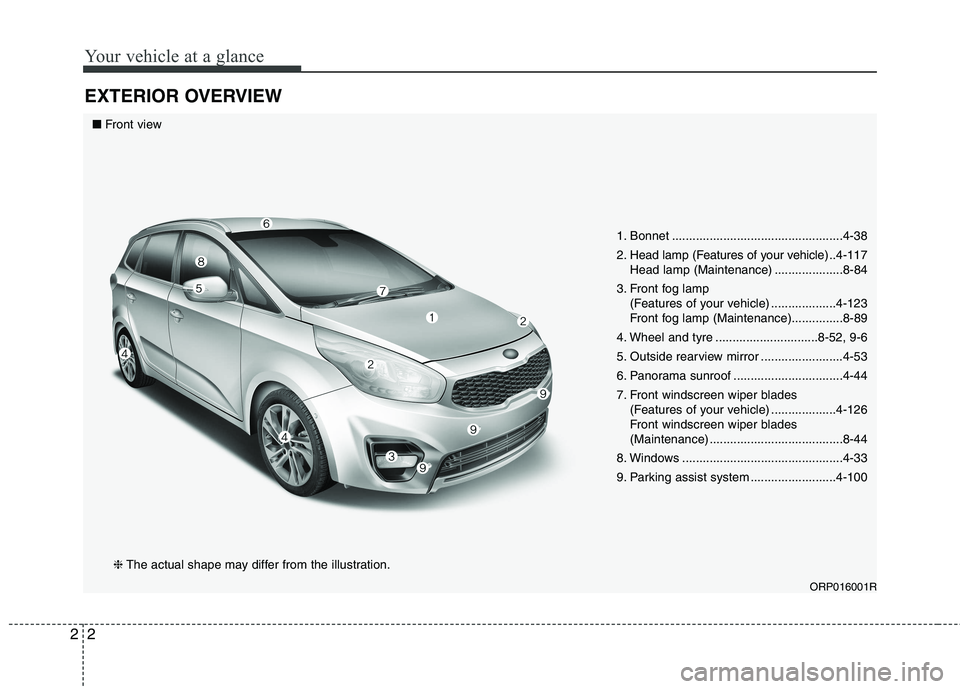
Your vehicle at a glance
2
2
EXTERIOR OVERVIEW
1. Bonnet ..................................................4-38
2. Head lamp (Features of your vehicle) ..4-117
Head lamp (Maintenance) ....................8-84
3. Front fog lamp (Features of your vehicle) ...................4-123
Front fog lamp (Maintenance)...............8-89
4. Wheel and tyre ..............................8-52, 9-6
5. Outside rearview mirror ........................4-53
6. Panorama sunroof ................................4-44
7. Front windscreen wiper blades (Features of your vehicle) ...................4-126
Front windscreen wiper blades
(Maintenance) .......................................8-44
8. Windows ...............................................4-33
9. Parking assist system .........................4-100
ORP016001R
■Front view
❈ The actual shape may differ from the illustration.
Page 13 of 723
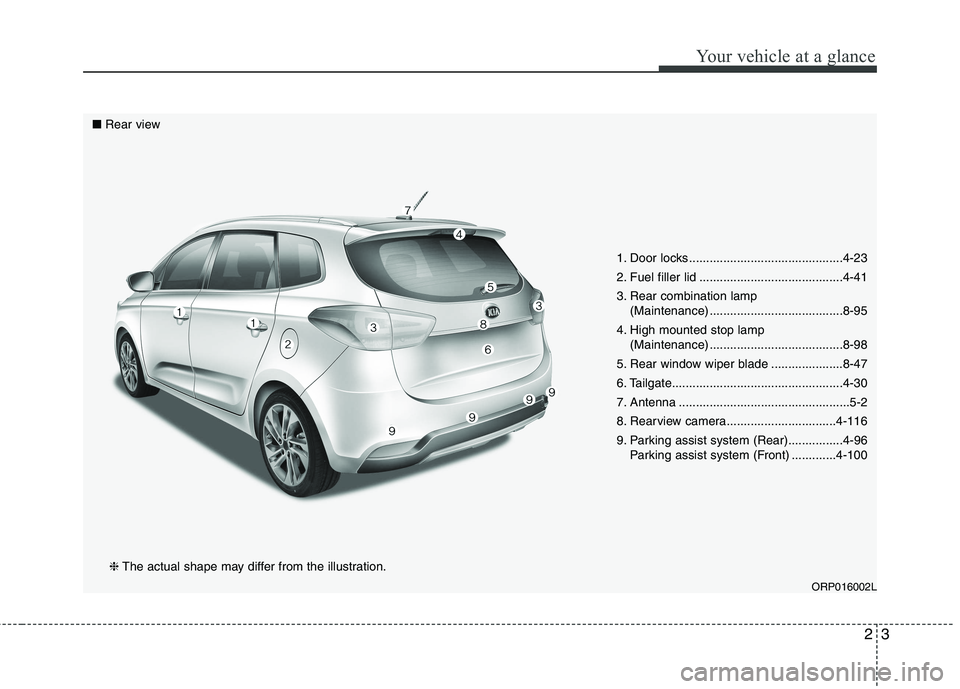
23
Your vehicle at a glance
1. Door locks .............................................4-23
2. Fuel filler lid ..........................................4-41
3. Rear combination lamp (Maintenance) .......................................8-95
4. High mounted stop lamp (Maintenance) .......................................8-98
5. Rear window wiper blade .....................8-47
6. Tailgate..................................................4-30
7. Antenna ..................................................5-2
8. Rearview camera................................4-116
9. Parking assist system (Rear)................4-96 Parking assist system (Front) .............4-100
ORP016002L
■Rear view
❈ The actual shape may differ from the illustration.
Page 14 of 723
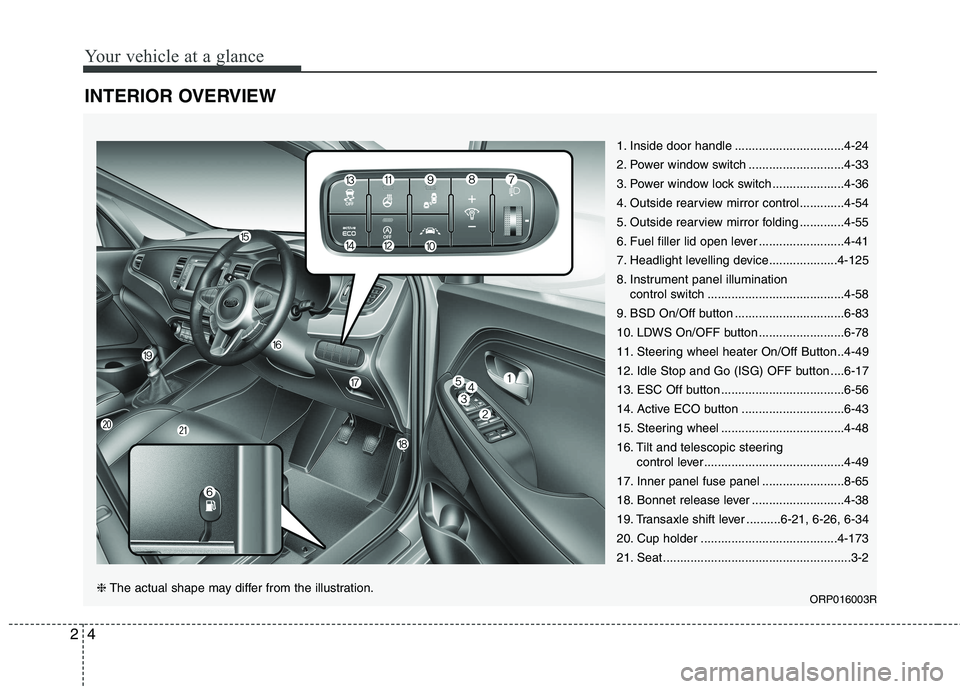
Your vehicle at a glance
4
2
INTERIOR OVERVIEW
1. Inside door handle ................................4-24
2. Power window switch ............................4-33
3. Power window lock switch .....................4-36
4. Outside rearview mirror control.............4-54
5. Outside rearview mirror folding .............4-55
6. Fuel filler lid open lever .........................4-41
7. Headlight levelling device....................4-125
8. Instrument panel illumination
control switch ........................................4-58
9. BSD On/Off button ................................6-83
10. LDWS On/OFF button .........................6-78
11. Steering wheel heater On/Off Button..4-49
12. Idle Stop and Go (ISG) OFF button ....6-17
13. ESC Off button ....................................6-56
14. Active ECO button ..............................6-43
15. Steering wheel ....................................4-48
16. Tilt and telescopic steering control lever.........................................4-49
17. Inner panel fuse panel ........................8-65
18. Bonnet release lever ...........................4-38
19. Transaxle shift lever ..........6-21, 6-26, 6-34
20. Cup holder ........................................4-173
21. Seat .......................................................3-2
ORP016003R
❈The actual shape may differ from the illustration.
Page 58 of 723

Safety features of your vehicle
40
3
WARNING
To reduce the chance of serious or fatal injuries:
Children of all ages are safer when restrained in the rear
seat. A child riding in the front
passenger seat can be force-
fully struck by an inflating air
bag resulting in serious orfatal injuries.
Always follow the child restraint system manufactur-
er’s instructions for installa-
tion and use of the childrestraint system.
Always make sure the child restraint system is secured
properly in the vehicle and your
child is securely restrained inthe Child restraint system.
Never hold a child in your arms or lap when riding in a
vehicle. The violent forces cre-ated during a crash will tear
the child from your arms and
throw the child against the
vehicle’s interior.
(Continued)(Continued)
Never put a seat belt overyourself and a child. During a
crash, the belt could press
deep into the child causingserious internal injuries.
Never leave children unat- tended in a vehicle – not even
for a short time. The vehicle
can heat up very quickly,resulting in serious injuries to
children inside the vehicle.
Even very young children may
inadvertently cause the vehi-
cle to move, entangle them-
selves in the windows, or lock
themselves or others inside
the vehicle.
Never allow two children, or any two persons, to use thesame seat belt.
Children often squirm and reposition themselves improp-
erly. Never let a child ride withthe shoulder belt under their
arm or behind their back.
Always properly position and
secure children in the rear seat.
(Continued)(Continued)
Never allow a child to stand-up or kneel on the seat or floor
of a moving vehicle. During a
collision or sudden stop, the
child can be violently thrown
against the vehicle’s interior,
resulting in serious injury.
Never use an infant carrier or a child restraint system that
"hooks" over a seatback, it
may not provide adequatesecurity in an accident.
Seat belts can become very hot, especially when the vehi-
cle is parked in direct sun-
light. Always check the seat
belt buckles before fastening
them over a child.
After an accident, have the system checked by a profes-
sional workshop. Kia recom-mends to visit an authorised
Kia dealer/service partner.
If there is not enough space to place the child restraint sys-tem because of the driver's
seat, install the child restraintsystem in the rear right seat.
Page 73 of 723

355
Safety features of your vehicle
There are even circumstancesunder which contact with the
steering wheel air bag can cause
fatal injuries, especially if the
occupant is positioned exces-
sively close to the steering wheel.Noise and smoke
When the air bags inflate, they make
a loud noise and they leave smoke
and powder in the air inside of the
vehicle. This is normal and is a result
of the ignition of the air bag inflator.
After the air bag inflates, you may
feel substantial discomfort in breath-
ing due to the contact of your chestwith both the seat belt and the air
bag, as well as from breathing the
smoke and powder. Open your
doors and/or windows as soon as
possible after impact in order to
reduce discomfort and prevent
prolonged exposure to the smoke
and powder.
Though smoke and powder are non-
toxic, it may cause irritation to the
skin (eyes, nose and throat, etc.). If
this is the case, wash and rinse with
cold water immediately and consult
the doctor if the symptom persists.
WARNING
To avoid severe personal injury or death caused by
deploying air bags in a colli-
sion, the driver should sit as
far back from the ste ering
wheel air bag. The front pas-
senger should always move
their seat as far back as pos-
sible and sit back in their seat.
Air bag inflates instantly in an event of a collision, passen-
gers may be injured by the air
bag expansion force if they
are not in a proper position.
Air bag inflation may cause injuries including facial or
bodily abrasions, injuries from
broken glasses or burns.
WARNING
When the air bags deploy, the air bag related parts in the steering wheel and/or instru-ment panel and/or in both
sides of the roof rails above
the front and rear doors are
very hot. To prevent injury, do
not touch the air bag storageareas internal components
immediately after an air baghas inflated.
Do not install or place any accessories near air bag
deployment areas, such as
the instrument panel, win-
dows, pillars, and roof rails.
Page 86 of 723
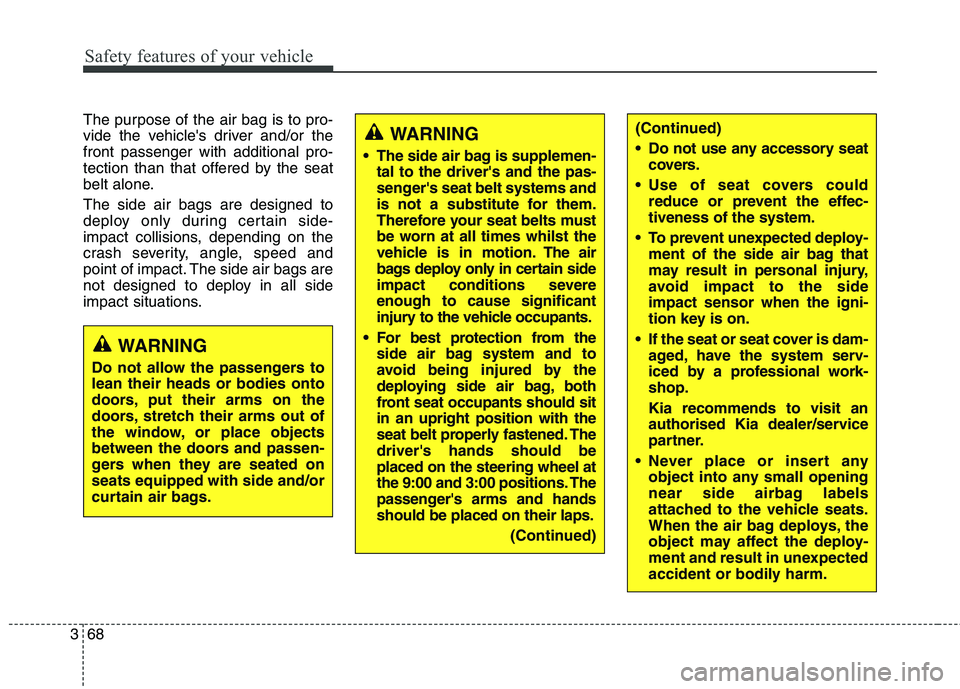
Safety features of your vehicle
68
3
The purpose of the air bag is to pro-
vide the vehicle's driver and/or thefront passenger with additional pro-
tection than that offered by the seat
belt alone. The side air bags are designed to
deploy only during certain side-
impact collisions, depending on the
crash severity, angle, speed and
point of impact. The side air bags are
not designed to deploy in all side
impact situations.
WARNING
Do not allow the passengers to lean their heads or bodies onto
doors, put their arms on the
doors, stretch their arms out of
the window, or place objects
between the doors and passen-
gers when they are seated onseats equipped with side and/or
curtain air bags.
WARNING
The side air bag is supplemen- tal to the driver's and the pas-
senger's seat belt systems and
is not a substitute for them.
Therefore your seat belts must
be worn at all times whilst the
vehicle is in motion. The air
bags deploy only in certain side
impact conditions severeenough to cause significant
injury to the vehicle occupants.
For best protection from the side air bag system and to
avoid being injured by the
deploying side air bag, both
front seat occupants should sitin an upright position with the
seat belt properly fastened. Thedriver's hands should beplaced on the steering wheel at
the 9:00 and 3:00 positions. The
passenger's arms and handsshould be placed on their laps.
(Continued)(Continued)
Do not use any accessory seatcovers.
Use of seat covers could reduce or prevent the effec- tiveness of the system.
To prevent unexpected deploy- ment of the side air bag that
may result in personal injury,
avoid impact to the sideimpact sensor when the igni-
tion key is on.
If the seat or seat cover is dam- aged, have the system serv-
iced by a professional work-shop. Kia recommends to visit an
authorised Kia dealer/service
partner.
Never place or insert any object into any small opening
near side airbag labels
attached to the vehicle seats.
When the air bag deploys, the
object may affect the deploy-
ment and result in unexpected
accident or bodily harm.
Page 88 of 723
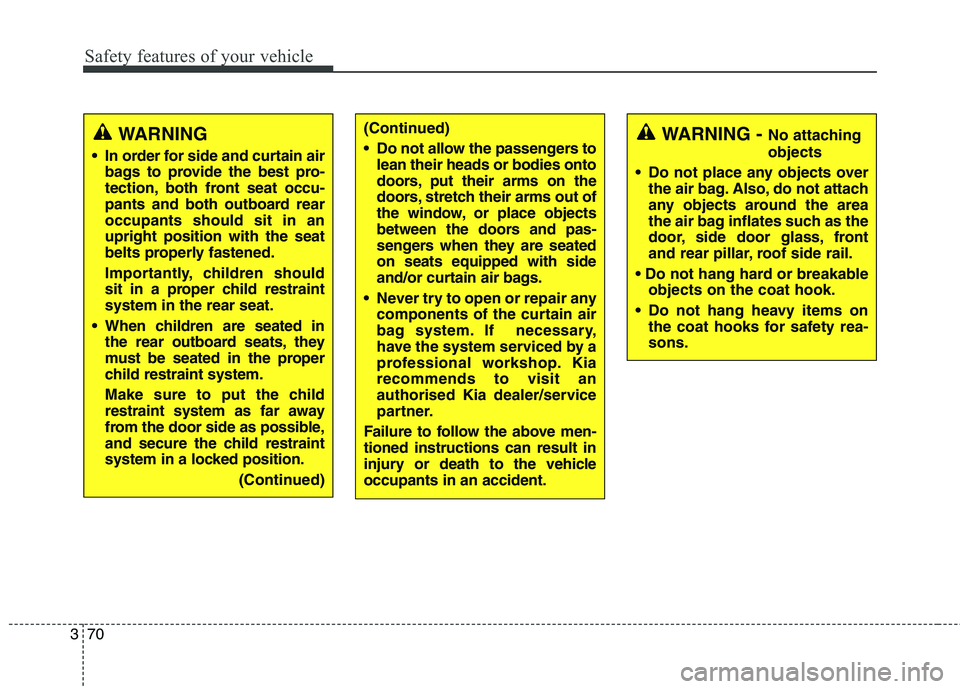
Safety features of your vehicle
70
3
(Continued)
Do not allow the passengers to
lean their heads or bodies onto
doors, put their arms on the
doors, stretch their arms out of
the window, or place objects
between the doors and pas-
sengers when they are seatedon seats equipped with side
and/or curtain air bags.
Never try to open or repair any components of the curtain air
bag system. If necessary,
have the system serviced by a
professional workshop. Kiarecommends to visit an
authorised Kia dealer/service
partner.
Failure to follow the above men-tioned instructions can result in
injury or death to the vehicleoccupants in an accident.WARNING
In order for side and curtain air bags to provide the best pro-
tection, both front seat occu-
pants and both outboard rearoccupants should sit in anupright position with the seat
belts properly fastened.
Importantly, children should
sit in a proper child restraintsystem in the rear seat.
When children are seated in the rear outboard seats, they
must be seated in the proper
child restraint system.
Make sure to put the child
restraint system as far away
from the door side as possible,
and secure the child restraint
system in a locked position.
(Continued)WARNING - No attaching objects
Do not place any objects over the air bag. Also, do not attach
any objects around the area
the air bag inflates such as the
door, side door glass, front
and rear pillar, roof side rail.
objects on the coat hook.
Do not hang heavy items on the coat hooks for safety rea-sons.
Page 97 of 723
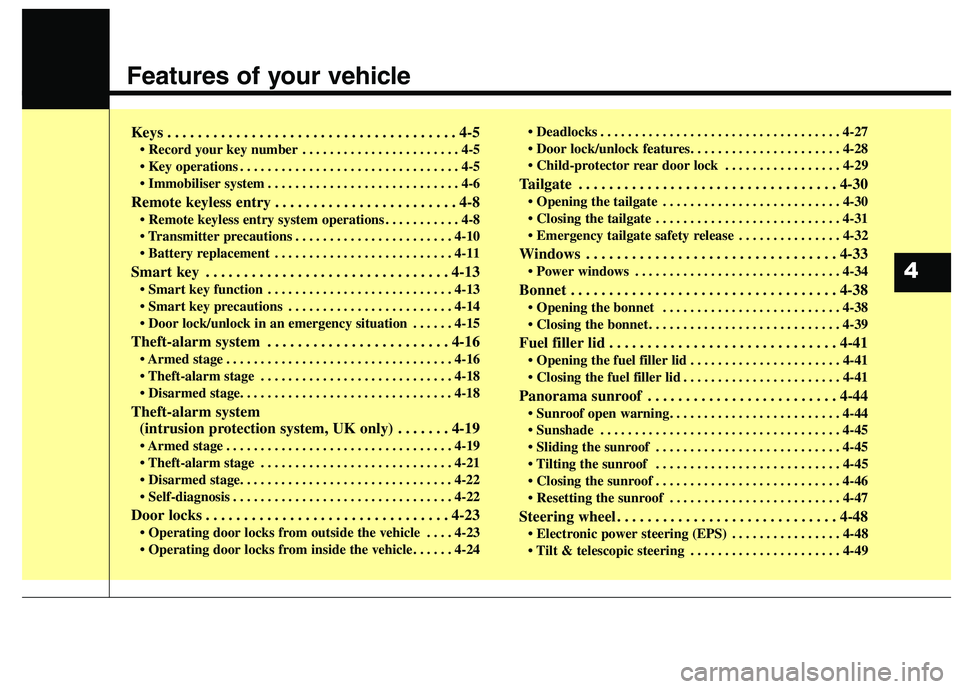
Features of your vehicle
Keys . . . . . . . . . . . . . . . . . . . . . . . . . . . . . . . . . . . . . . 4-5• Record your key number . . . . . . . . . . . . . . . . . . . . . . . 4-5
. . . . . . . . . . . . . . . . . . . . . . . . . . . . . . . . 4-5
. . . . . . . . . . . . . . . . . . . . . . . . . . . . 4-6
Remote keyless entry . . . . . . . . . . . . . . . . . . . . . . . . 4-8 . . . . . . . . . . . 4-8
. . . . . . . . . . . . . . . . . . . . . . . 4-10
. . . . . . . . . . . . . . . . . . . . . . . . . . 4-11
Smart key . . . . . . . . . . . . . . . . . . . . . . . . . . . . . . . . 4-13 . . . . . . . . . . . . . . . . . . . . . . . . . . . 4-13
. . . . . . . . . . . . . . . . . . . . . . . . 4-14
. . . . . . 4-15
Theft-alarm system . . . . . . . . . . . . . . . . . . . . . . . . 4-16 . . . . . . . . . . . . . . . . . . . . . . . . . . . . . . . . . 4-16
. . . . . . . . . . . . . . . . . . . . . . . . . . . . 4-18
Theft-alarm system (intrusion protection system, UK only) . . . . . . . 4-19 . . . . . . . . . . . . . . . . . . . . . . . . . . . . . . . . . 4-19
. . . . . . . . . . . . . . . . . . . . . . . . . . . . 4-21
. . . . . . . . . . . . . . . . . . . . . . . . . . . . . . . . 4-22
Door locks . . . . . . . . . . . . . . . . . . . . . . . . . . . . . . . . 4-23 . . . . 4-23
. . . . . . . . . . . . . . . . . . . . . . . . . . . . . . . . . . . 4-27
. . . . . . . . . . . . . . . . . 4-29
Tailgate . . . . . . . . . . . . . . . . . . . . . . . . . . . . . . . . . . 4-30 . . . . . . . . . . . . . . . . . . . . . . . . . . 4-30
. . . . . . . . . . . . . . . . . . . . . . . . . . . 4-31
. . . . . . . . . . . . . . . 4-32
Windows . . . . . . . . . . . . . . . . . . . . . . . . . . . . . . . . . 4-33 . . . . . . . . . . . . . . . . . . . . . . . . . . . . . . 4-34
Bonnet . . . . . . . . . . . . . . . . . . . . . . . . . . . . . . . . . . . 4-38 . . . . . . . . . . . . . . . . . . . . . . . . . . 4-38
. . . . . . . . . . . . . . . . . . . . . . . . . . . . 4-39
Fuel filler lid . . . . . . . . . . . . . . . . . . . . . . . . . . . . . . 4-41 . . . . . . . . . . . . . . . . . . . . . . 4-41
. . . . . . . . . . . . . . . . . . . . . . . 4-41
Panorama sunroof . . . . . . . . . . . . . . . . . . . . . . . . . 4-44
. . . . . . . . . . . . . . . . . . . . . . . . . . . . . . . . . . . 4-45
. . . . . . . . . . . . . . . . . . . . . . . . . . . 4-45
. . . . . . . . . . . . . . . . . . . . . . . . . . . 4-45
. . . . . . . . . . . . . . . . . . . . . . . . . . . 4-46
. . . . . . . . . . . . . . . . . . . . . . . . . 4-47
Steering wheel . . . . . . . . . . . . . . . . . . . . . . . . . . . . . 4-48 . . . . . . . . . . . . . . . . 4-48
. . . . . . . . . . . . . . . . . . . . . . 4-49
4
Page 117 of 723
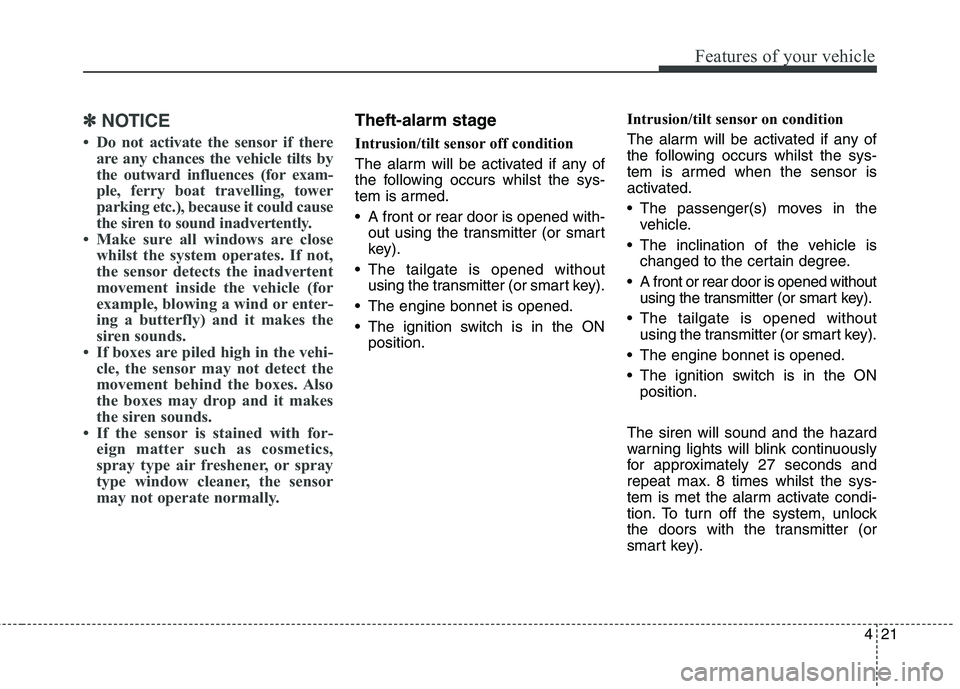
421
Features of your vehicle
✽✽NOTICE
Do not activate the sensor if there are any chances the vehicle tilts by
the outward influences (for exam-
ple, ferry boat travelling, tower
parking etc.), because it could cause
the siren to sound inadvertently.
Make sure all windows are close whilst the system operates. If not,
the sensor detects the inadvertent
movement inside the vehicle (for
example, blowing a wind or enter-
ing a butterfly) and it makes the
siren sounds.
If boxes are piled high in the vehi- cle, the sensor may not detect the
movement behind the boxes. Also
the boxes may drop and it makes
the siren sounds.
If the sensor is stained with for- eign matter such as cosmetics,
spray type air freshener, or spray
type window cleaner, the sensor
may not operate normally.Theft-alarm stage
Intrusion/tilt sensor off condition
The alarm will be activated if any of
the following occurs whilst the sys-
tem is armed.
A front or rear door is opened with-out using the transmitter (or smart
key).
The tailgate is opened without using the transmitter (or smart key).
The engine bonnet is opened.
The ignition switch is in the ON position. Intrusion/tilt sensor on condition
The alarm will be activated if any of
the following occurs whilst the sys-
tem is armed when the sensor is
activated.
The passenger(s) moves in the
vehicle.
The inclination of the vehicle is changed to the certain degree.
A front or rear door is opened without using the transmitter (or smart key).
The tailgate is opened without using the transmitter (or smart key).
The engine bonnet is opened.
The ignition switch is in the ON position.
The siren will sound and the hazard
warning lights will blink continuously
for approximately 27 seconds and
repeat max. 8 times whilst the sys-
tem is met the alarm activate condi-
tion. To turn off the system, unlock
the doors with the transmitter (or
smart key).
Page 122 of 723
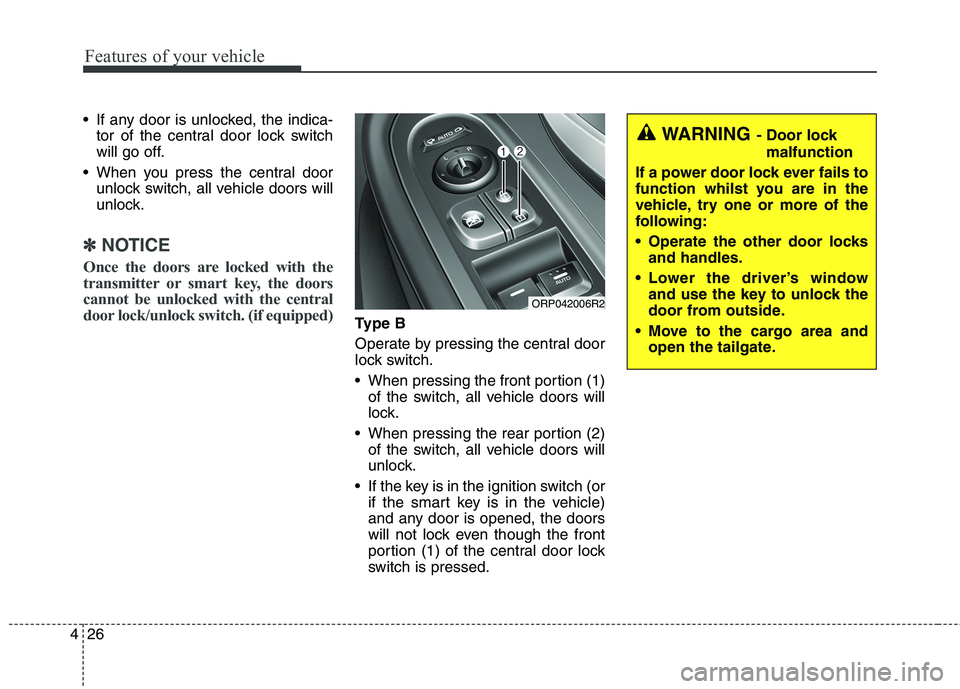
Features of your vehicle
26
4
If any door is unlocked, the indica-
tor of the central door lock switch
will go off.
When you press the central door unlock switch, all vehicle doors will
unlock.
✽✽ NOTICE
Once the doors are locked with the
transmitter or smart key, the doors
cannot be unlocked with the central
door lock/unlock switch. (if equipped)
Type B
Operate by pressing the central door
lock switch.
When pressing the front portion (1) of the switch, all vehicle doors will
lock.
When pressing the rear portion (2) of the switch, all vehicle doors will
unlock.
If the key is in the ignition switch (or if the smart key is in the vehicle)
and any door is opened, the doors
will not lock even though the front
portion (1) of the central door lock
switch is pressed.
WARNING - Door lock
malfunction
If a power door lock ever fails to
function whilst you are in the
vehicle, try one or more of the
following:
Operate the other door locks and handles.
Lower the driver’s window and use the key to unlock the
door from outside.
Move to the cargo area and open the tailgate.
ORP042006R2